The University of York has launched a £5.4m project with the Royal College of Art (RCA), focusing on sustainable fashion. Led by York biologist Professor Simon McQueen-Mason, the team of scientists have discovered a method which turns waste into fashion.
Growing impact of the textile industry
The textile industry is increasingly having disastrous effects on the environment. In the current “throwaway society” culture, clothing is only kept for a few years before being disposed of and replaced. One million tonnes of fabric are sent to the incinerator or landfill per year in the UK. On a global scale, a recent study demonstrated that the apparel retail market net worth is equal to the world’s 126 poorest countries’ GDP combined.
Simon McQueen-Mason explains that ‘the clothing and fashion sector is currently one of the most polluting, responsible for 10% of global greenhouse gas emissions and 20% of global waste water.’
The impact the textile industry has on pollution is undoubtedly worsening. Emission rates, particularly with synthetic fibres, are high for textile production. When combined with growing outsourcing of factories to developing countries, these emission rates rise further.
Water usage is also high in textile production. Particularly for cotton and wool, the use of these fabrics to create clothing use excess amounts of water. A singular cotton coat can use up to 10,000 litres of water.
The textile contribution to water and air pollution has also reached a worrying stage. Crude oil is often used in the production of synthetic clothing, and this is frequently disposed of improperly. The result is constant leakage into waterways, or burning into the atmosphere.
Turning Waste into Fashion
The team of scientists in York have discovered a way to reuse textile, household, and crop waste. Using enzyme technology, they break down the materials into simple sugars. These sugars are converted into cellulose using bacteria. The cellulose is spun into fibres.
The cellulose fibres are transferred from the University of York to the University of Cranfield. Here, the fibres will be spun to create new textiles.
The Royal College of Art then coordinates for students the design and make clothing using these textiles. As well as RCA students, students from the universities of Leeds, Manchester, Cambridge, and University College London, will all be partaking in the project.
The creation of these textiles from waste materials could have huge implications for the textile industry. Emissions could reduce as the need for the UK to import textiles would be lower. In addition, the need to create new synthetic fibres would be lessened too.
Professor McQueen-Mason also adds that ‘our approach will dramatically reduce the carbon emissions and waste water from textile production. As a result, it will create a more secure domestic supply chain.’
This project forms a section of the Royal College of Art’s Textile Circulatory Centre. The centre works to create better economic, social, and environmental outcomes in the UK through the input of academia, industry, NGOs, and the public sector. The centre receives funding from UK Research and Innovation.









